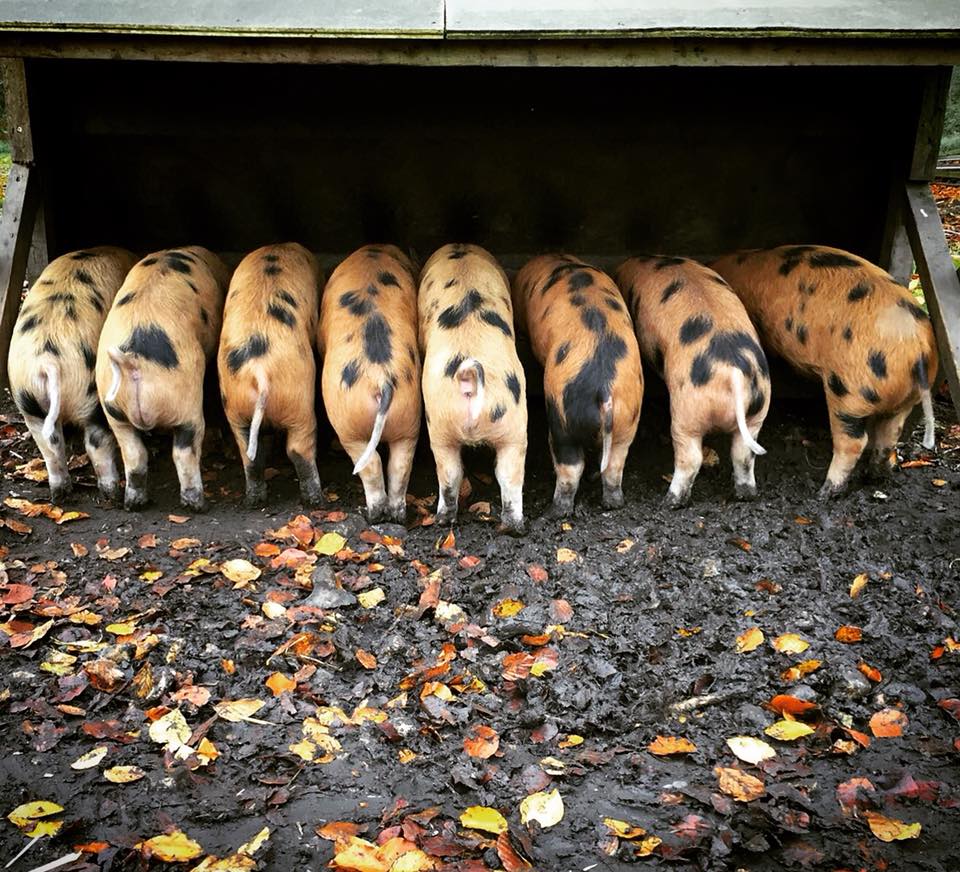
Biting in pigs is not uncommon and can manifest in various forms, such as tail, ear, flank, stifle, anus, belly, vulva, and even penis biting, all of which are different types of cannibalism. However, tail biting is viewed as the most widespread and serious of them all and thankfully rarely seen within the Independent Pork Producer sector. It is true to say that it is most common within the corporate sector. However, it has been observed within the IPP sector, whereby rare/traditional pig breeds are running indoor systems with some experiencing this condition as well a other issues which is underlining the need to seek advice on space and layout of running an indoor system.
Research has suggested that the overall frequency of tail biting is 1.2% and that the frequency in different systems highlights the widespread nature of the problem. No one system of pig keeping is immune from tail biting. Slatted systems have seen a prevalence of 2% of pigs affected whilst on straw the figure is only 0.4%. Growers from indoor systems are 50% more likely to be tail bitten than those born outdoors. (NADIS data table below)

Yes, we would all like to see pen mates get along but sadly there will always be a bit of argy-bargy and as a result can harbour a loss within our pig industry. Tail biting is observed under many circumstances and different situations with different action intensity. In a severe situation, 3-5% of pigs may be affected and with this in mind it would not be unusual for 1% to be euthanised and a similar number are condemned at slaughter, which is written up as “pyaemia”.
Information obtained from pig abattoirs in England suggests that the recorded incidence of tail bitten pigs presented for slaughter is much lower than clinical surveillance, as it is due to on farm cases taking action of pigs being destroyed humanely as they are unfit for presentation for slaughter for human consumption.
Causes
Pigs do have a natural tendency to chew and it would be akin to teething. Lets not forget as covered in various blogs the growth of our pigs teeth is changing as at 4 weeks of age they will experience new teeth and again at 8 months. With this in mind research has concluded that once at the “teething stage” they will be biting and chewing anything to pacify the sensation hence tail biting starts, the draw of blood is a great attraction and it is said that it become contagious. Normal inquisitive investigation with the mouth can lead to “accidental” bleeding, which can lead to more serious damage.
When tail biting occurs, it is wise to assess, observe and identify the culprit and the damage of the wound and treat and remove the injured pig
Tailing biting reasons are endless with the main factors being:
- environmental
- dietary
- husbandry factors
- overstocking and understocking,
- temperature variation,
- draughts,
- competition for food and water,
- Vitamin E deficiency
- high fat diets.
It is paramount that veterinary advice is seeked to help identify the cause of “unhappy pigs”. The inability of some pigs to find a comfortable draught free lying area is one of the major triggers for tail biting recognised on farm.
Such areas for consideration include:-
- Thermal comfort:- draughts, temperature variation, chilling and over-heating are highly significant factors.
- Freely available feed and water – the pig that is unable to get to a free supply of feed and water is always more likely to seek revenge on its pen mates.
- Feed diets that are appropriate to the pig and contain a full balance of nutrients.
- Stocking density. Space provision should be determined by the nature of the accommodation and the requirements of the specific pigs. if stocking rates are too low thermal comfort may be difficult to achieve and trigger tail biting. If stocking rates are to high then again thermal comfort will be too high and can trigger tail biting.
Treatment
Wounded pigs must be isolated to prevent further damage. Spray and treat the bitten tail with an antiseptic spray. The bitten tail can be dressed/sprayed with antiseptic or proprietary “antibiting” sprays can be applied. Stockholm Tar can also be applied but do seek veterinary advice.
It is worth noting that any wound presented and observed on the tail of a pig must be dealt with immediately, as this can leave an open window for bacteria to travel through the tail wound up the main lymph column under the spine whereby abscesses in or close to the spinal canal will form. Again, these will be observed at slaughter and therefore the carcass will be condemned. Also on farm observation will see paralysis in the live pig. Also infection can spread to joints producing arthritis.
As a rule of thumb any pig that is known to have been tail bitten and is lame due to joint swelling requires on farm euthanasia.
Prevention
One or two features can be added to help our pigs and reduce any incidences that may arise whether we are outdoor or indoors and these are:
1. Providing toys in the form of chewable material. Chains, alcathene piping, rubber boots, wood etc are valuable but must be in place at all times. Straw, sawdust, peat is also a requirement if you choose to keep your pigs indoors
2. Look at dietary content, nutrition
3. Review stocking rates, health control protocols and overall health management of the herd to minimise the trigger factors for tail biting.
4. Undertake a review of ventilation systems including smoke tests and temperature gradient measurements and correct any faults.
Join the Charity on Facebook, twitter and instagram – osbpiggroup
Please also visit the OSBPG Shop and Become a Friend Or Donate to help us continue our work in creating a better future for our breed, it existence and its breeding potential to further enhance the knowledge for our future generation.